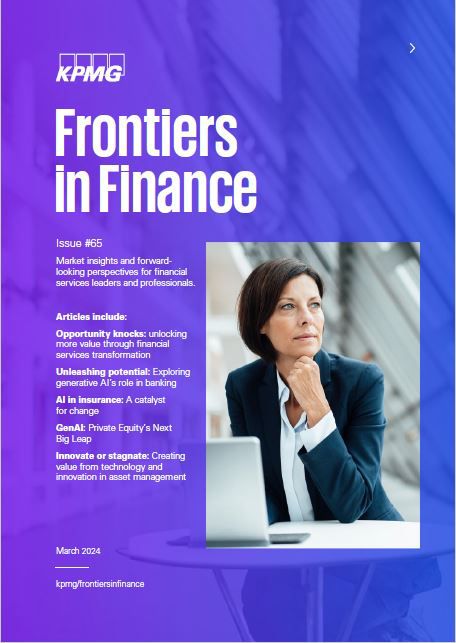Author: Paul Greenan, Global Lead Digital Transformation, KPMG International and Partner, Financial Services, KPMG in the UK
Banking executives have always been quick to embrace new technologies. First, it was the internet and quickly created online banking services. Banks turned smartphones into mobile banking solutions. Cloud allowed them to collaborate with clients and colleagues in real-time. Now, they see genAI emerging and are asking themselves (and the rest of the business) how this new and disruptive technology might change their world for the better.
Bank executives are clearly very bullish about the potential of genAI. In fact, in the KPMG global tech report 2023, 61 percent of banking technology leaders said they believe genAI, AI and machine learning will be critical to enabling the business to achieve its short-term ambitions. Conversations
with bank technology leaders suggest they are inundated with requests from the business for genAI support.

Seeing past the hype
Rarely has a new technology garnered so much attention. When ChatGPT launched in late November 2022, it took just five days to attract 1 million users. Consumer media ran with the story. Executives spent the holiday season playing with it. And by January it was estimated to have reached 100 million monthly active users.1 Bankers poured back into the office with dreams of massive productivity improvements and — perhaps — a bit more free time.
However, it is worth taking a step back from the hype to really understand what genAI is, what it can do, and the risks and opportunities involved. It is not the silver bullet to every banker’s problem. It is a key part of society in which people and machines work together.
At this point in its development, genAI can be categorized into five main buckets:
- Content generators: GenAI can be used to write routine documents and communications, such as emails or announcements, or to generate images. For example, a bank may use a content generator to create the first draft of a marketing email, thereby allowing bank employees to focus on editing rather than writing.
- Information extractors: Bankers might use genAI to summarize and analyze larger documents, in short and long-form — this could be particularly useful when looking for anomalies across a range of similar documents like employee benefits contracts, for example, or supplier terms and conditions.
- Smart chatbots: This would be an upgrade to the traditional narrowly programmed chatbots most banks use today, using genAI to enable conversational interactions that are based on a defined logic. They will likely be deployed internally at first (for example, to allow employees to find out how many vacation days they have remaining), before being adopted into higher-risk client solutions.
- Language translators: GenAI tools make fantastic language translators and are able — to with a high level of reliability — translate and build new content in multiple languages simultaneously. This should allow banks to add a new level of personalization to their client and employee communications.
- Code generators: Somewhat related, genAI can convert text and natural language into code for various programing languages. This could be particularly useful for banks seeking to update their old Common Business Oriented Language (COBOL)-based programs using new-generation coding skills or for those seeking to enable low-code/no-code business solutions.
Moving quickly but carefully
Banks are innovative. But they are also (rightfully) risk averse. For now, most applications of generative AI and large language models (LLMs) that you may have seen in banks have been limited to lower-risk internal purposes.
Some chatbots have been deployed to manage employee queries about product terms and conditions, for example, or to provide details on employee benefits programs. KPMG professionals have helped banks pilot genAI as information extractors to find anomalies within contracts or flag potentially fraudulent transactions. GenAI has also been used to quickly create bits of code that allow legacy systems to interact with new technologies.
There are thousands of potential use cases for genAI in banking. A recent report, The generative AI advantage in financial services, by KPMG in the US, found that 76 percent of executives plan to use generative in fraud and prevention, 62 percent in customer service and personalization and 68 percent in compliance and risk.2 Yet, for now, most banks are moving cautiously — using internal experimentation to learn iteratively and building proof-of-concepts around external use cases.
Potential banking genAI use case:
GenAI can assist in loan underwriting by analyzing a customer financial data and helping to reduce the risk of default. With a better understanding of their customers’ needs and wants, genAI can help create personalized product recommendations, such as credit card offers, and cross-sell new products to existing customers.
Looking behind the curtain
To be clear, banks have every reason to be cautious when it comes to AI — generative AI in particular. The biggest concern is around bias. AI is only as good as the data it is trained on. If the model receives biased data, it will make biased decisions. Large language models and generative AI systems are trained on massive amounts of data, leaving significant room for bias to creep in.
Tied to this are concerns around explainability. AI often operates within a ‘black box’ that even its developers don’t always understand, which means that the decisions being made by the model aren’t always auditable or explainable. True: you can ask genAI to justify its decision, but those justifications are also based on a generative model, creating an eternal loop of inexplicability. Until the explainability piece is solved, banks will likely remain hesitant to unleash AI in some higher-risk areas.
Bank CEOs are also concerned that genAI might be a double-edged sword when it comes to cyber security. On the one hand, most seem to believe that the technology could dramatically increase their ability to detect and predict attacks. But, at the same time, they worry that the enterprise adoption of a new technology might create new attack vectors.
Understanding the cost
The KPMG global tech report 2023, suggest that banking technology leaders are already seeing the positive benefits of AI and automation more broadly. More than three-in-ten leaders say it has likely increased their profitability or performance by 11 percent or more. However, the research also suggests they are increasingly worried about the costs that the technology may bring to the business

There are two cost buckets to consider. The first is the implementation costs — building out new apps, training them, integrating them into existing systems, testing them, putting them into production and so on. That all takes massive amounts of computing power, loads of data and access to highly skilled people. Centers of excellence may help balance that cost in the initial phases but will likely slow adoption in the long run.
The second cost bucket is operational. As much processing power, computing and energy as it takes to create a model, it takes multiples of that to maintain it. Spin up thousands of different models across the enterprise and the costs rapidly multiply (as do carbon emissions). While the efficiency
of existing models is rising and the cost of deploying LLMs is dropping, the market continues to see newer, larger and more capable models being deployed.
Some might suggest that headcount reductions will rapidly offset these costs. Yet this might be a somewhat optimistic view. Everyone thought desktop computers would lead to mass redundancies. But they didn’t. Nor did spreadsheets, process automation or email. What they did do, however, was allow people to focus on the more value-adding parts of their jobs. GenAI is expected to do
the same.
Indeed, the survey of bank technology leaders indicates that the biggest benefit most banks see from their use of AI and automation is raised employee satisfaction levels. KPMG professionals have talked with employees who are delighted about the increased level of customer service they can provide thanks to automation and AI. Others say they are inspired by working on higher value tasks and activities.

Focusing on transformation
Rather than considering genAI as cost or productivity play, bank leaders should think of it as a growth and transformation play. That means going beyond use cases and siloed productivity gains to focus on broader processes and holistic outcomes instead. Think of it like this: A siloed implementation of genAI into a particular workstream could, perhaps, garner a 5 percent productivity gain. And, when multiplied a hundred times, it can certainly make a cost difference.
What’s better, however, is when you can integrate genAI across a broader process. Take a risk process, for example. Policies are based on a set of laws. Controls are put in place to ensure compliance. Quality control is used to drive improvements. Apply genAI across the process and you can start to run the various steps in parallel. QC findings trigger updates to policies in real-time, for example. And these kinds of applications could deliver productivity gains of, say, 75 percent.
Where it gets amazing is when it starts to fundamentally change ‘the possible’. And this is the world of 500 percent productivity gains. It’s where the productivity gains get to a point where you can start to do things you never thought possible. Take financial close as a limited example. With genAI and a host of other complementary technologies applied, one could theoretically start to run a continuous close. Hook some visualization tools up to that data, and CEOs and decision-makers could
tap into a real-time dashboard of key financial, compliance, risk and cost metrics, for example.
The point is that — if banks were to focus purely on individual siloed use cases and cost outcomes — they would be missing the big opportunities that genAI can deliver. Those only come when you think holistically and focus on outcomes rather than costs.
Three takeaways
Around the world, KPMG banking and technology professionals have been hard at work helping clients think through the opportunities, risks and implications of genAI. And while there is still a lot to learn, there are three key themes that continue to resonate.
- Tackle your biggest problems. Don’t implement genAI for the fear of missing out. This is about helping the business address big problems — speed to market with new products, for example, or risk processes. Understand the business outcome you want to achieve and then consider how you can use genAI to help solve those problems.
- Go for transformation. All hype aside, genAI is creating fundamentally new approaches and models that can have a truly transformative impact on banks. Executives should be looking for big impacts at an enterprise level rather than focusing on siloed use cases and productivity gains. This is an opportunity to fundamentally rethink the way the business operates.
- Right now, experimentation and innovation are critical. Given the pace of change, this is no time to fall behind. But it must be done within the framework of smart governance and risk management. The desire to move quickly must be balanced against the risks. GenAI can help unlock massive benefits, but only when it is applied smartly, responsibly, and holistically.
KPMG Trusted AI
KPMG firms are excited about AI’s opportunities and equally committed to deploying the technology in a way that is responsible, trustworthy, safe and free from bias. KPMG Trusted AI, is our strategic approach and framework to designing, building, deploying and using AI solution in a responsible and ethical manner so we can accelerate value with confidence.
How KPMG professionals can help
The KPMG global organization of banking professionals works with clients to set their vision for the future, execute digital transformation and deliver managed services. KPMG people combine deep industry experience with extensive technology capabilities to help you achieve your organization’s goals.
Global, multi-disciplinary teams of professionals strive to deliver successful outcomes in the banking sector. KPMG professionals use close connections and their understanding of key issues, with deep industry knowledge to help drive successful and sustainable technology and business transformations.
Special thanks to the following who helped to contribute to this article:
Mark Shank Principal, Advisory, Lighthouse KPMG in the US
Paul Henninger, Head of KPMG Global Lighthouse and Head UK Connected Technology, Partner, KPMG in the UK
Sanjay Doshi, Partner, Financial Services Advisory Leader, KPMG in India

Frontiers in Finance: Issue 65
Market insights and forward-looking perspectives for financial services leaders and professionals.
Download magazine (1.9 MB)Continue reading
1 “ChatGPT sets record for fastest-growing user base — analyst note.” Reuters website, 2 February 2023.
2 KPMG in the US, “The generative AI advantage in financial services” (August 2023).








